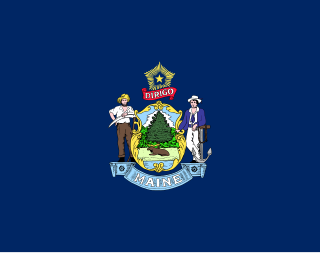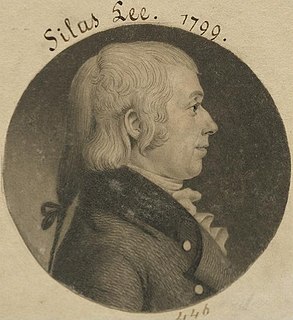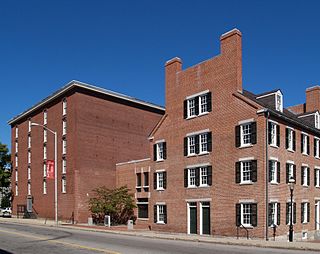
Lincoln County is a county located in the U.S. state of Maine. As of the 2010 census, the population was 34,457. Its seat is Wiscasset. The county was founded in 1760 from a portion of York County, Massachusetts and named after the English city Lincoln, the birthplace of Massachusetts Bay Provincial Governor Thomas Pownall.
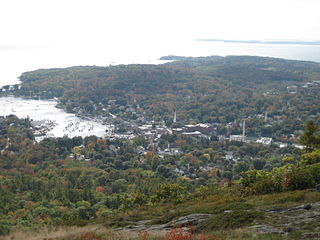
Camden is a town in Knox County, Maine, United States. The population was 4,850 at the 2010 census. The population of the town more than triples during the summer months, due to tourists and summer residents. Camden is a famous summer colony in the Mid-Coast region of Maine. Similar to Bar Harbor, Nantucket and North Haven, Camden is well known for its summer community of wealthy Northeasterners, mostly from Boston, New York and Philadelphia.

Fort Edgecomb, built in 1808–1809, is a two-story octagonal wooden blockhouse with restored fortifications located on Davis Island in the town of Edgecomb, Lincoln County, Maine, United States. It is the centerpiece of the Fort Edgecomb State Historic Site. It was added to the National Register of Historic Places in 1969, with its boundaries increased to create a historic district in 1991.

Stratford Hall is a historic house museum near Lerty in Westmoreland County, Virginia. It was the plantation house of four generations of the Lee family of Virginia. It was the boyhood home of two signers of the Declaration of Independence, Richard Henry Lee (1732-1794), and Francis Lightfoot Lee (1734-1797), and it was the birthplace of Robert Edward Lee (1807–1870), who was a longtime military officer in the Corps of Engineers in the United States Army, and later General-in-Chief of the Confederate States Army and commanded its Army of Northern Virginia during the American Civil War (1861-1865), and then became the president of Washington College, which later became Washington and Lee University in Lexington, Virginia. The estate was designated a National Historic Landmark in 1960, under the care of the National Park Service in the U.S. Department of the Interior.
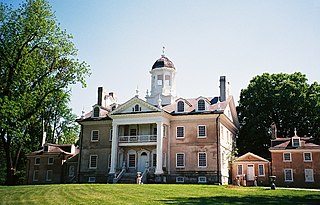
Hampton National Historic Site, in the Hampton area north of Towson, Baltimore County, Maryland, USA, preserves a remnant of a vast 18th-century estate, including a Georgian manor house, gardens, grounds, and the original stone slave quarters. The estate was owned by the Ridgely family for seven generations, from 1745 to 1948. The Hampton Mansion was the largest private home in America when it was completed in 1790 and today is considered to be one of the finest examples of Georgian architecture in the U.S. Its furnishings, together with the estate's slave quarters and other preserved structures, provide insight into the life of late 18th-century and early 19th-century landowning aristocracy. In 1948, Hampton was the first site selected as a National Historical Site for its architectural significance by the U.S. National Park Service. The grounds were widely admired in the 19th century for their elaborate parterres or formal gardens, which have been restored to resemble their appearance during the 1820s. Several trees are more than 200 years old. In addition to the mansion and grounds, visitors may tour the overseer's house and slave quarters.

The Maine State House in Augusta, Maine is the state capitol of the State of Maine. The building was completed in 1832, one year after Augusta became the capital of Maine. Built using Maine granite, the State House was based on the design of the Massachusetts State House.
The year 1807 in architecture involved some significant events.

Bacon's Castle, also variously known as "Allen's Brick House" or the "Arthur Allen House" is located in Surry County, Virginia, United States, and is the oldest documented brick dwelling in what is now the United States. Built in 1665, it is noted as an extremely rare example of Jacobean architecture in the New World.

The Nickels-Sortwell House is a historic house museum at 121 Main Street in Wiscasset, Maine, United States. Built in 1807 by a wealthy ship's captain, the house was designated a National Historic Landmark in 1970 as an exceptionally high-quality example of the Federal style of architecture. After serving as a hotel for much of the 19th century, the house returned to private hands in 1900. It was given to Historic New England in 1958, which gives tours of the house between May and October.
Abiel Wood was a U.S. Representative from Massachusetts. Born in Wiscasset, Maine, he was the son of Gen. Abiel Wood (1743–1811) and Betsey Tinkham, both originally of Middleborough, Massachusetts. He was the second of eleven children. Wood attended the common schools, then engaged in mercantile pursuits. He served as member of the Massachusetts House of Representatives 1807–1811, and again in 1816.
Isaac Reed was a United States Representative from Maine.

Victoria Mansion, also known as the Morse-Libby House or Morse-Libby Mansion, is a landmark example of American residential architecture located in downtown Portland, Maine, United States. The brownstone exterior, elaborate interior design, opulent furnishings and early technological conveniences provide a detailed portrait of lavish living in nineteenth-century America. It was declared a National Historic Landmark in 1971 for its architectural significance as a particularly well-preserved Italianate mansion.

Historic Strawberry Mansion is a summer home originally named Summerville by Judge William Lewis who had it built sometime between 1783 and 1789. It is located in East Fairmount Park, Philadelphia, Pennsylvania, United States.

Togus is a facility operated by the United States Department of Veterans Affairs in Chelsea, Maine. The facility was built as a resort hotel, and housed Union veterans of the American Civil War prior to being converted to a veterans hospital. It was the first veterans facility developed by the United States government.

Once called the "most photographed house in the state" of Maine, the Wedding Cake House, known formally as the George W. Bourne House, is a historic house located at 104 Summer Street in Kennebunk, Maine. The home was built in 1825 by shipbuilder George W. Bourne (1801–1856), who later built a frame barn which he connected to the main house with a carriage house. In 1852, the barn caught fire and the carriage house was demolished to keep the fire from spreading to the house. Bourne, who during a European tour had been impressed by the Gothic beauty of the cathedral at Milan, rebuilt the carriage house and barn in what later came to be known as Carpenter Gothic style. Using hand tools, he crafted five buttresses with pinnacles on top of each. Then in order to tie the new structures in with the existing house, he added six buttresses with pinnacles to the house and then joined them together with intricate woodwork. His only help in doing this was Thomas Durrell, an apprentice ship's carpenter. Bourne spent the rest of his life adding to these embellishments. It has been said of Bourne: "The highly skilled carpenter knew no limits to his skill."

Red's Eats is a take-out restaurant located in Wiscasset, Maine. It is one of the most well-known and most written about restaurants in the state.

The Wiscasset Historic District is a 101-acre (41 ha) historic district that encompasses substantially all of the central village of Wiscasset, Maine. The district includes at least 22 contributing buildings and two other contributing sites, one being a cemetery whose oldest stone is from 1739. Located on the west bank of the Sheepscot River and settled in the 18th century, Wiscasset was a prominent harbor in Mid Coast Maine, and a major shipbuilding and merchant port, until the War of 1812 ended its prosperity. The village center includes fine examples of Federal period architecture, most built between about 1780 and 1820, including one National Historic Landmark, the Nickels-Sortwell House. The district was listed on the National Register of Historic Places in 1973.

